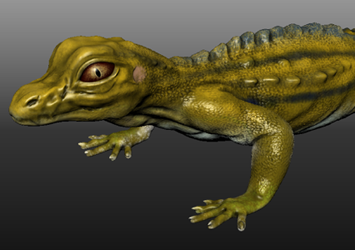
Autodesk® Mudbox™ version 2009 includes a number of new features and improvements that will enhance your production pipeline and productivity.
Mudbox is now available on Windows XP x64 and Windows Vista XP x64 which allows users to address far more memory and work with much larger meshes than ever before.
Mudbox now includes a new and powerful 3D texture painting toolset that lets you paint images as diffuse, bump, specular, reflection, and other textures across multiple high-resolution maps onto your 3D models. For more information, see Painting overview.
In paint mode, the brush position relative to the model is calculated in true world space; paint is projected tangent to the model, allowing for precise detail application where required, regardless of UV distortion.
In addition, stencils and stamps can be used with the painting feature to create interesting textures on your 3D models. For more information see Paint using brush stamps and Paint using stencil projection.
Mudbox 2009 has been redesigned to let you work much more interactively and subdivide polygonal meshes in the range of tens of millions of polygons while using sculpting tools that are now faster and more fluid than in previous versions. For tips on further optimizing memory usage and interactive performance, see Best practices for memory optimization.
Many real-time rendering effects have been added to Mudbox 2009 that leverage the power of your computer’s graphics card to let you view your models and textures in a 3D working environment that closely mimics your final target platform - be it a games console, film, television, or real-world product.
For example, you can apply filters on the 3D View to simulate a camera’s depth of field, or add ambient occlusion to simulate a more realistic shading in cracks and crevices on a model, or adjust the overall tone mapping in the view when High Dynamic Range (HDRI) images are used. For more information, see Apply visual effects.
You can save your favorite material, viewport filter, or display settings on the Material Presets tray.
Mudbox now supports the CgFX material specification on qualified graphics cards. CgFX is a shader specification that enables the creation of custom materials that use the power of your computer’s graphics card to produce many interesting materials and rendering effects in real time.
The main advantage of developing and using CgFX materials is that they are portable across many hardware and software applications (for example, between Maya and Mudbox) as well as other hardware platforms that support the CgFx specification. (for example, games consoles). For more information, see Using CgFX-based materials.
Additional light types and light presets
Mudbox now includes point and image-based lights. In addition, lighting presets can be stored to the a new Lighting Presets tray. A sample of HDR images for use with image-based lights is included with this version. For more information, see Create and edit lights.
The Sculpt Tools tray now includes additional sculpt tool presets (Fill, Scrape, and Knife are but a few examples) which have been organized in a fashion to make your sculpting work easier. For more information, see Sculpting presets.
The Layers window has been enhanced to support multiple paint layers in addition to the 3D sculpting layers. This lets users select and blend between several images for each texture channel, as well as combine or organize source imagery before projecting it onto their model. For more information, see Sculpt using layers and Paint using layers.
Texture extraction interface improved
The options window for texture extraction (now called Extract Texture Maps), has been completely overhauled to be much easier to use. A new texture extraction troubleshooting topic has been added to the Mudbox Help to aid in achieving optimal results when exporting normal or displacement maps. For more information, see Extract a texture map.
Sculpt using a displacement map
The Mesh Displacement feature has been renamed to Sculpt Model Using Displacement Map and its user interface has been simplified to be much easier than in version 1.0.7. For more information, see Sculpt using a displacement map.
A UV View has been added to let you view the layout of UV texture coordinates for an active model. The UV View also displays the active paint layer image in relation to the UVs so is useful when performing texture painting. For more information, see View painted images with UVs.
A new Steady Stroke feature has been added to the Stroke properties for the sculpting tools. Steady Stroke works by letting you preview a vector of your stroke’s direction/path before it’s drawn and lets you create much smoother strokes as a result. For more information, see Sculpt Tool properties.
Many of the tool trays have been reorganized and renamed to better accommodate the new 3D paint tools and render features. The Value Paint tool tray no longer exists and its contents (Freeze, Mask, and Erase) are now located in the Sculpt Tools tray. The selection tools are now located on the Select/Move Tools tray. For more information, see Trays.
A wide variety of new stencil and stamp presets have been added to the tool trays to help you create an infinite variety of effects when you sculpt or paint within Mudbox. Stamp and stencil images are 16-bit depth. For instructions on creating your own stencils and stamps using Adobe Photoshop, see Create images for stencils and stamps.
A new heads-up display feature has been added to the 3D View to momentarily display helpful tool tips and status information at key stages while you work. It’s goal is to assist both new and experienced users alike. For more information, see Heads-up Display.
The wireframe display feature has been improved for this release to let you display the shaded polygonal model and the wireframe simultaneously. For more information, see Change the model display.